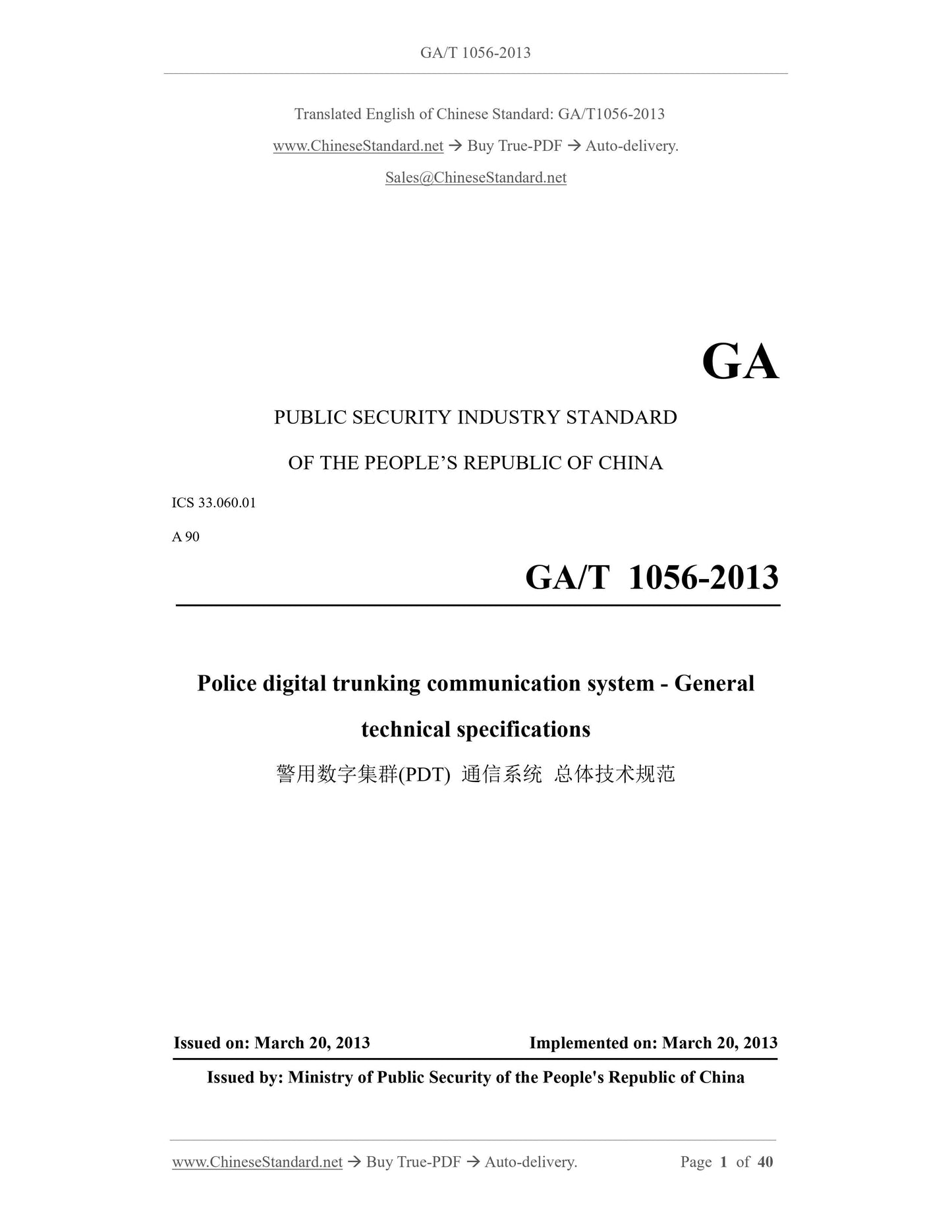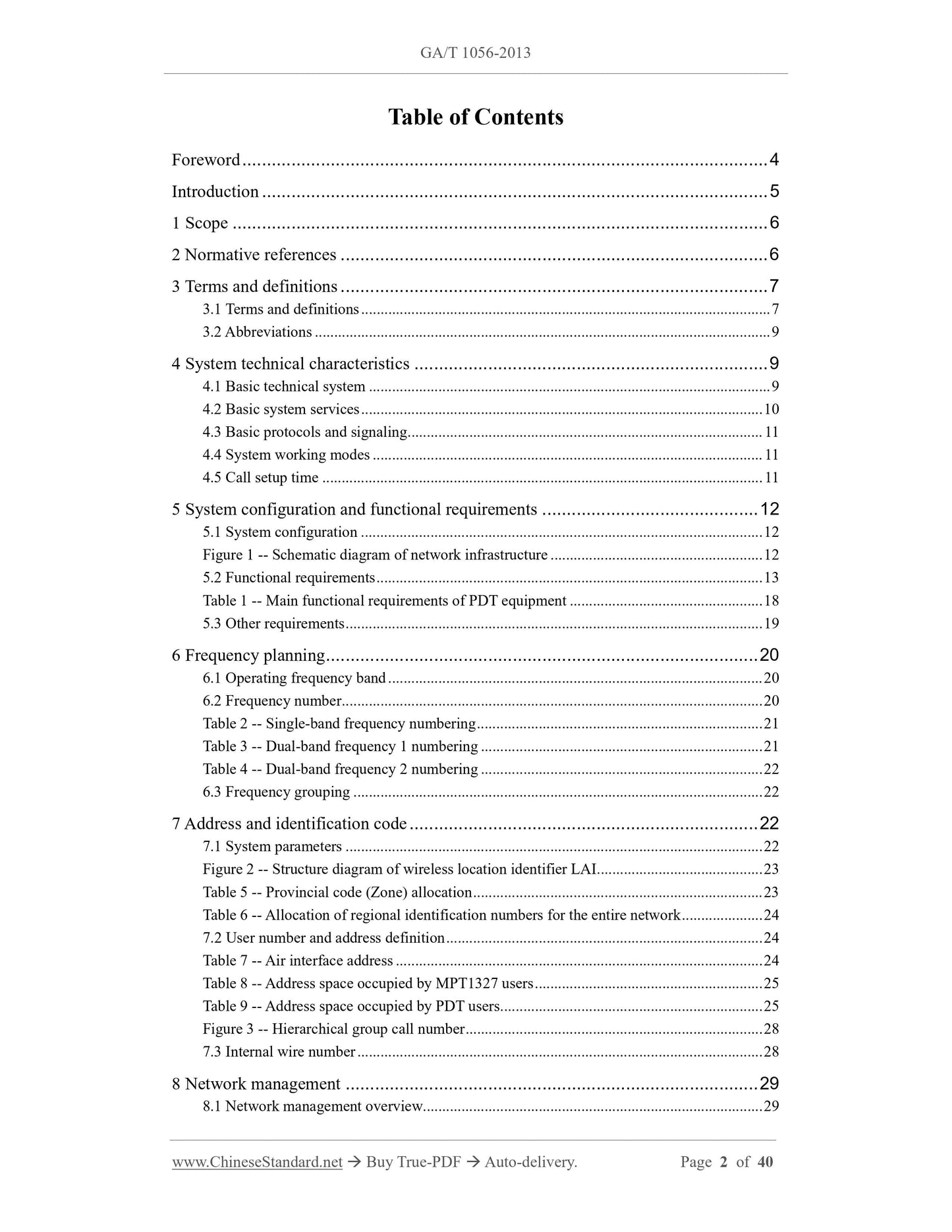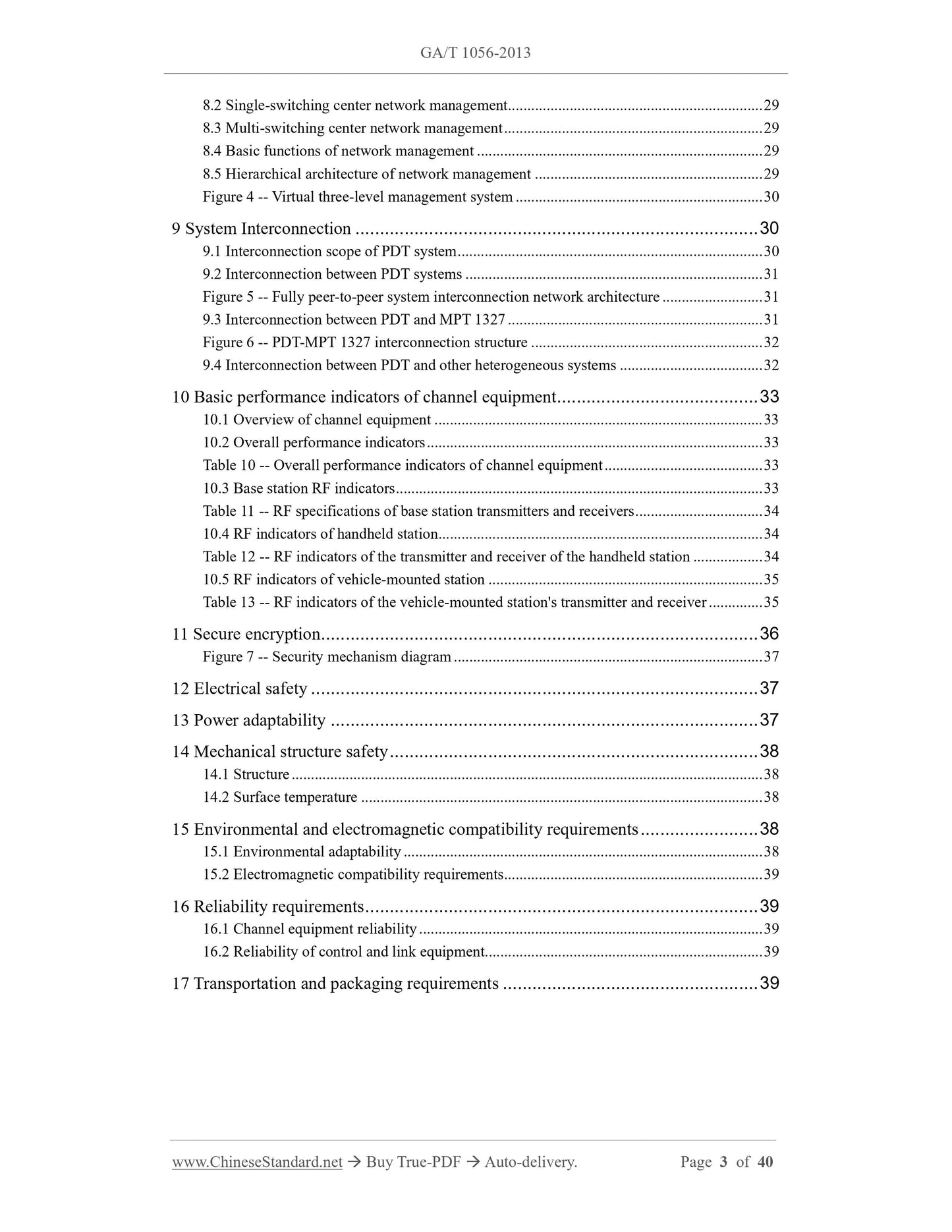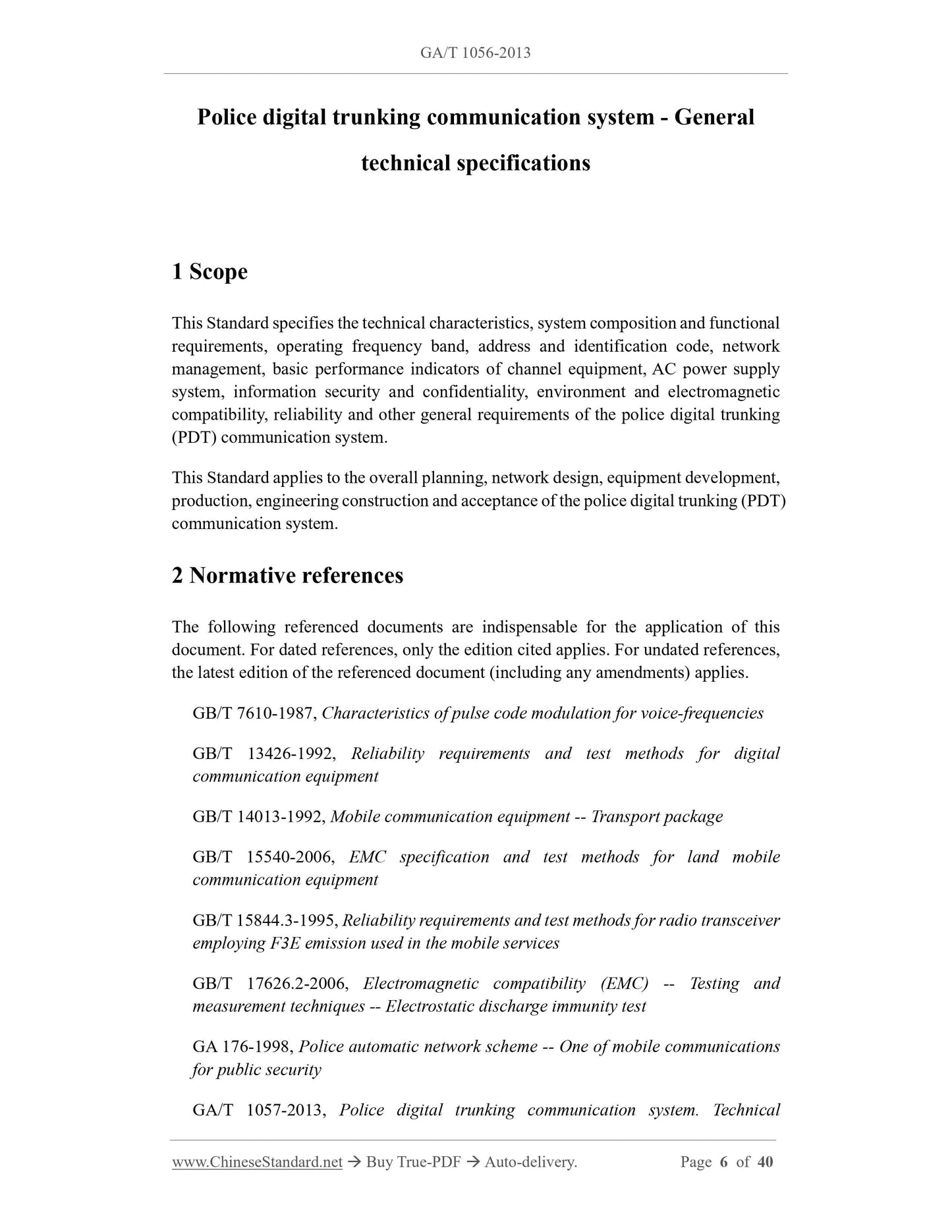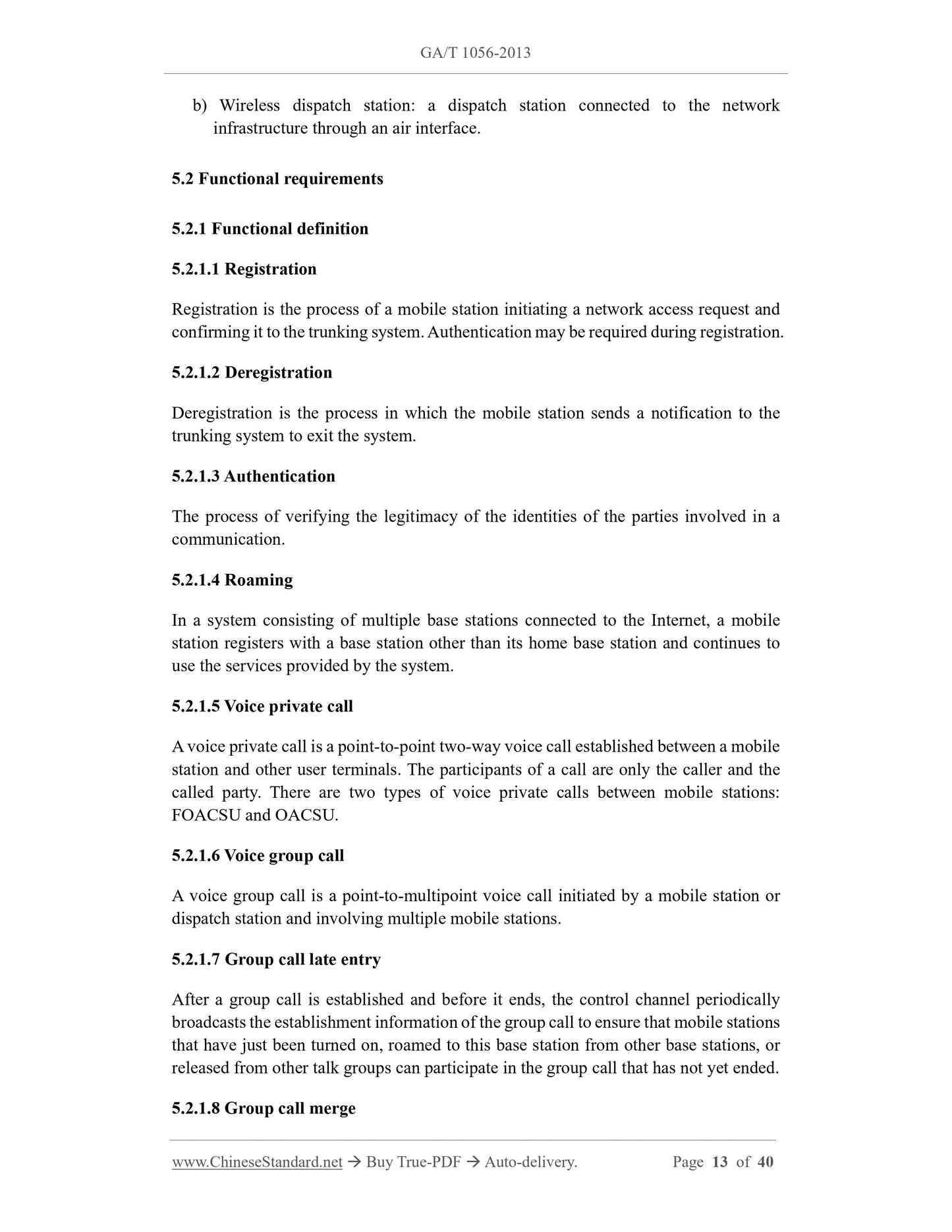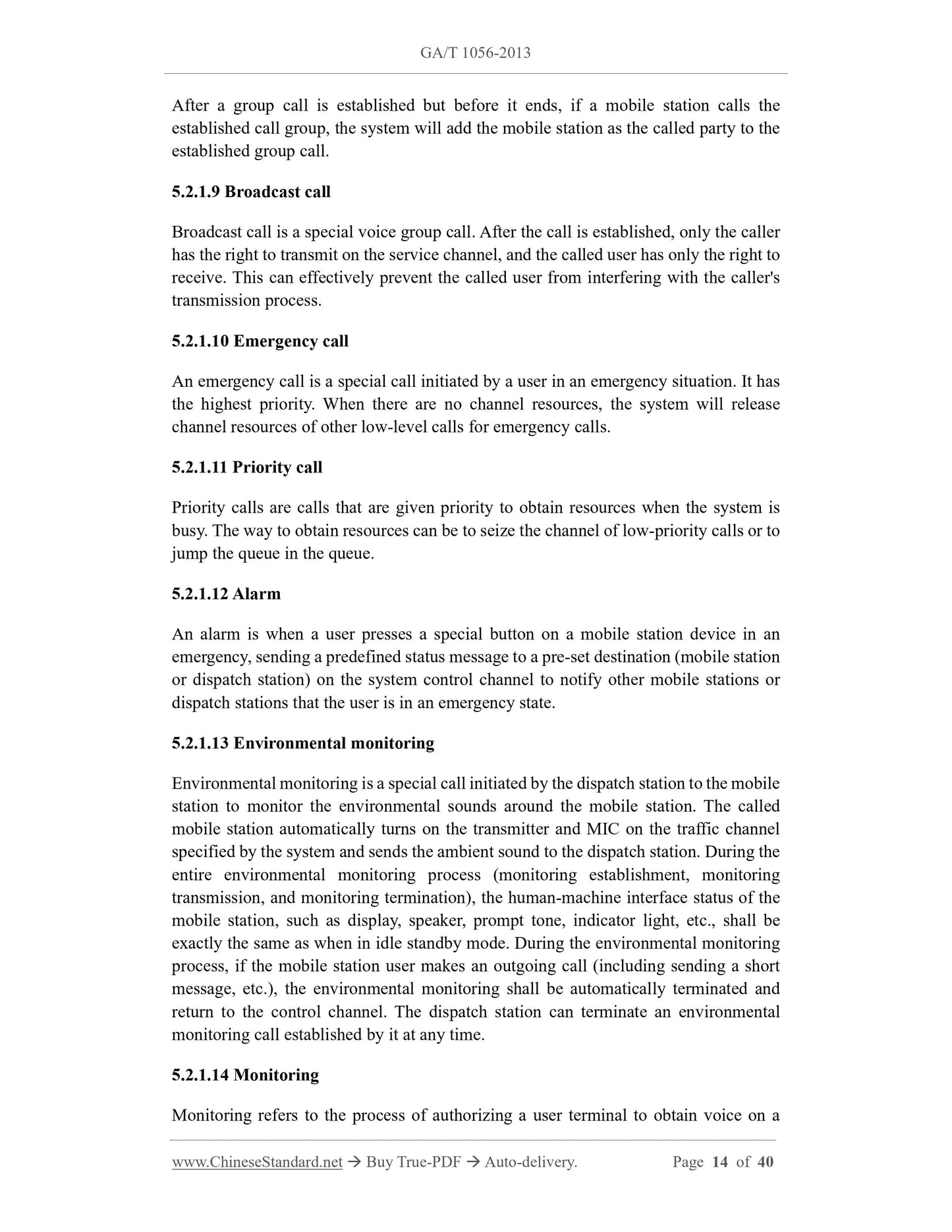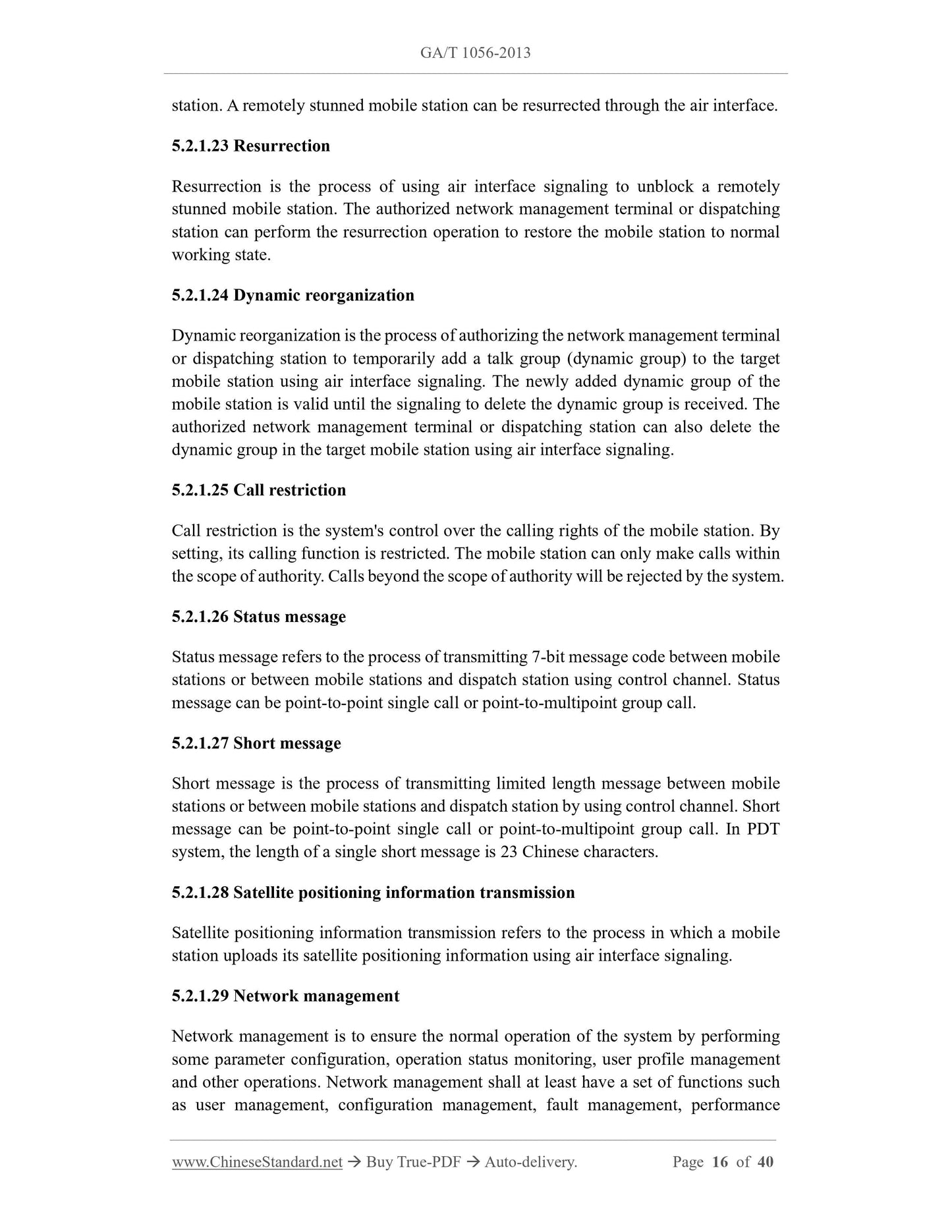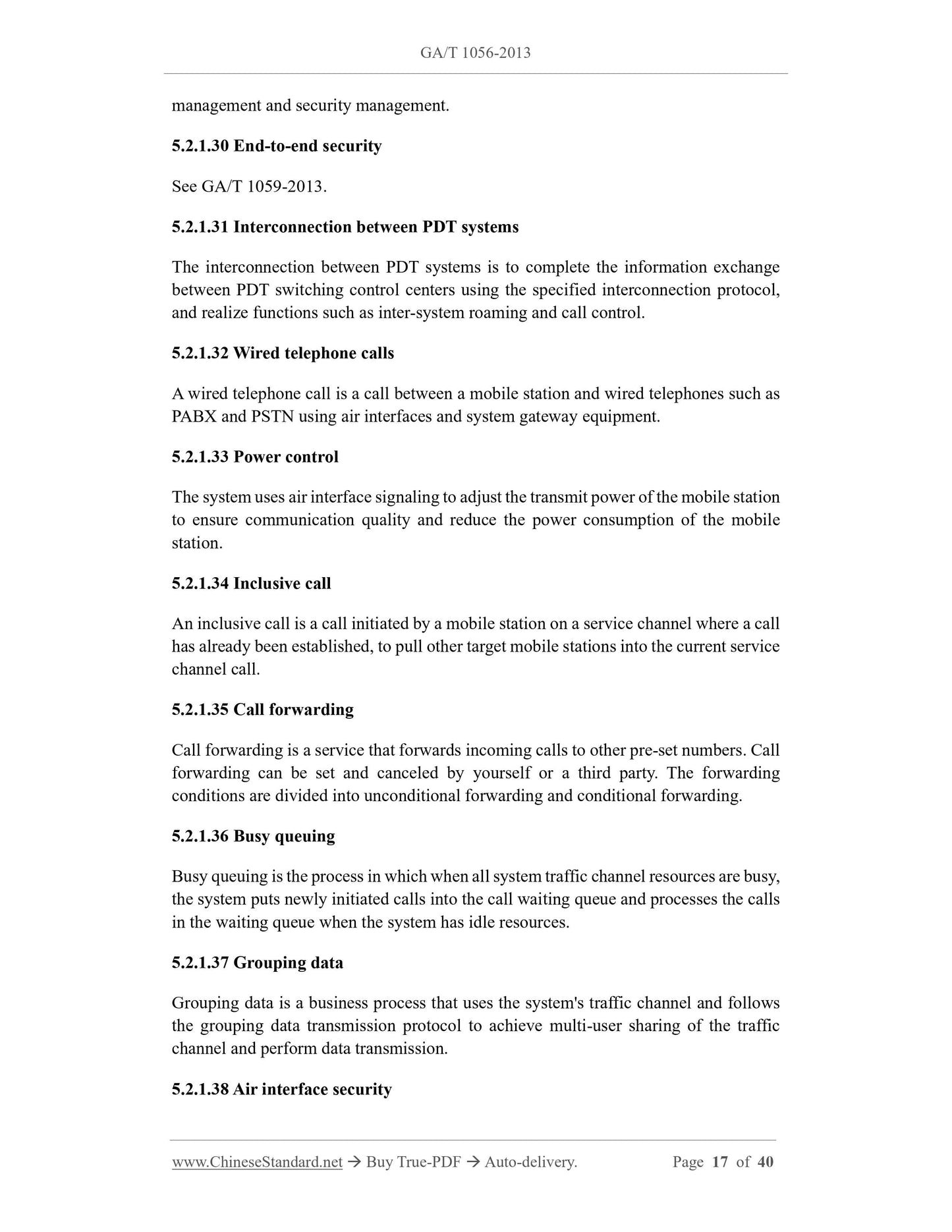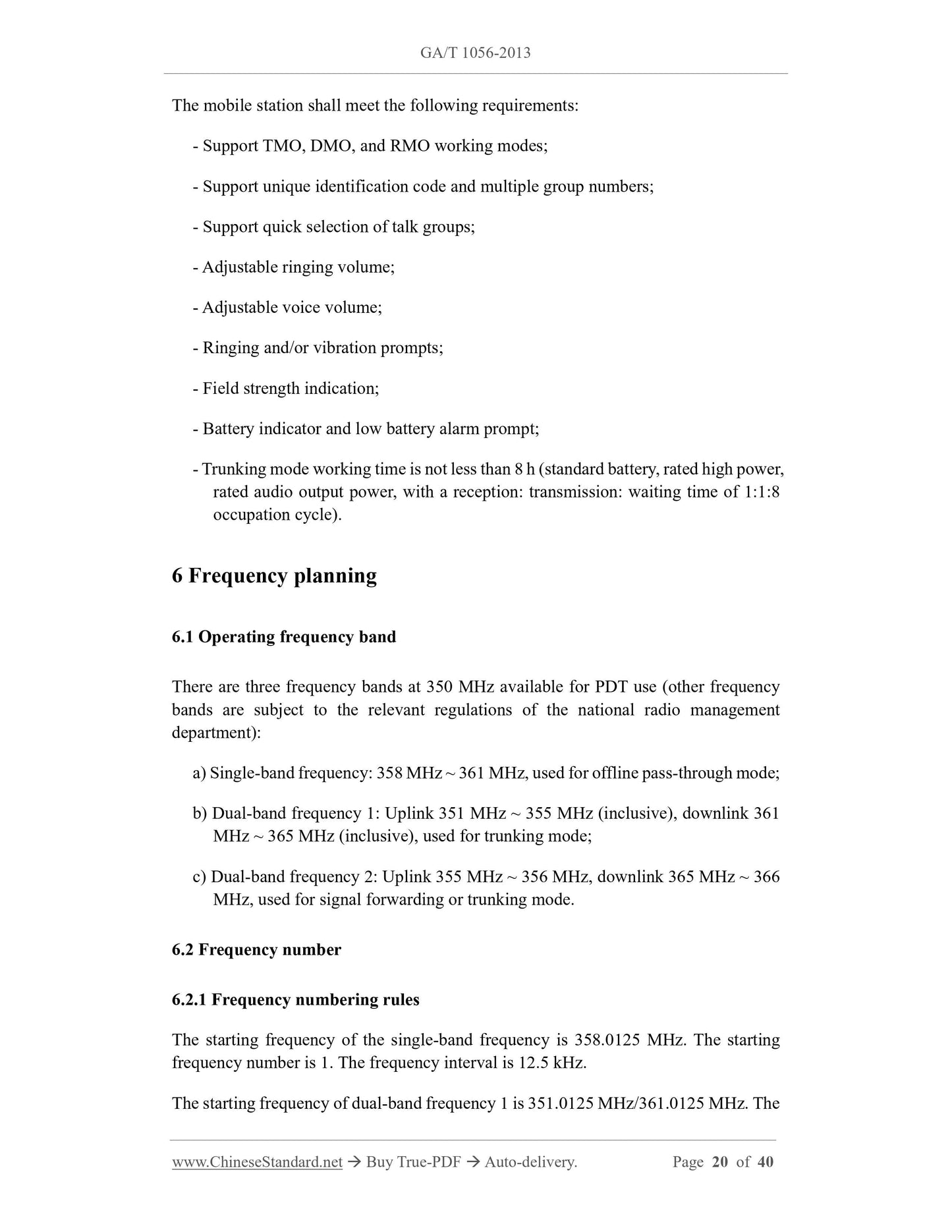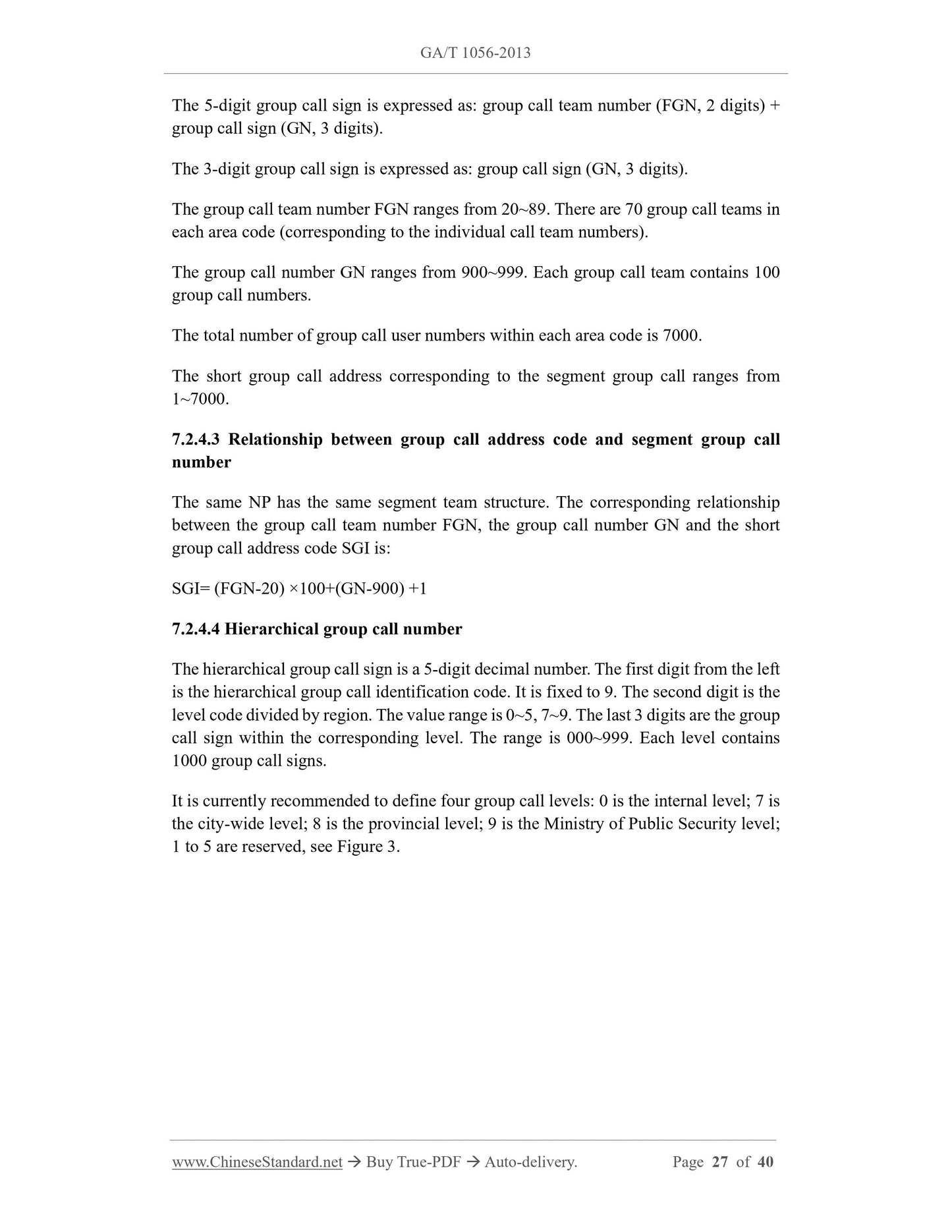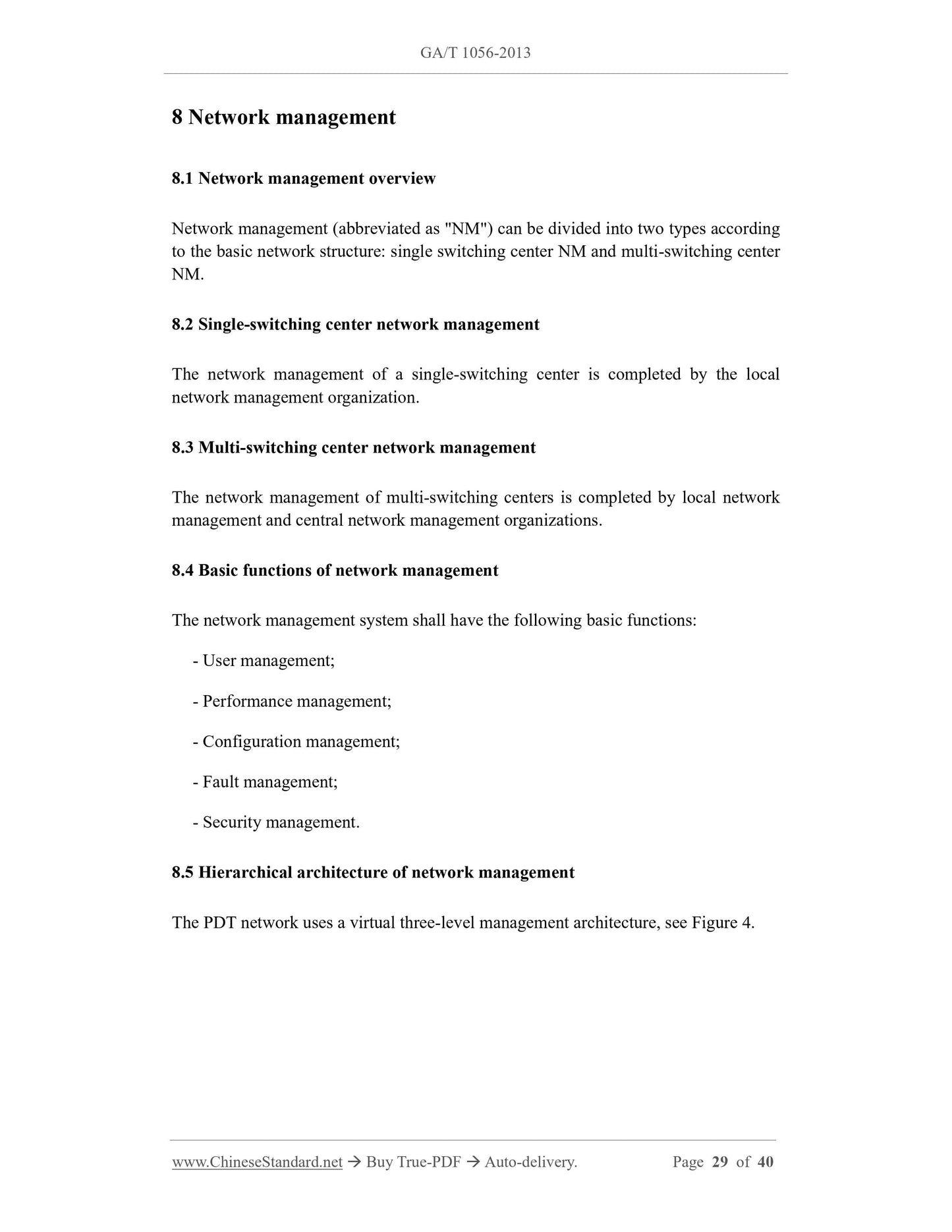PayPal, credit cards. Download editable-PDF and invoice in 1 second!
GA/T 1056-2013 English PDF (GAT1056-2013)
GA/T 1056-2013 English PDF (GAT1056-2013)
Precio habitual
$950.00 USD
Precio habitual
Precio de oferta
$950.00 USD
Precio unitario
/
por
Los gastos de envío se calculan en la pantalla de pago.
No se pudo cargar la disponibilidad de retiro
Delivery: 3 seconds. Download true-PDF + Invoice.
Get QUOTATION in 1-minute: Click GA/T 1056-2013
Historical versions: GA/T 1056-2013
Preview True-PDF (Reload/Scroll if blank)
GA/T 1056-2013: Police digital trunking communication system-General technical specifications
GA/T 1056-2013
GA
PUBLIC SECURITY INDUSTRY STANDARD
OF THE PEOPLE’S REPUBLIC OF CHINA
ICS 33.060.01
A 90
Police digital trunking communication system - General
technical specifications
ISSUED ON: MARCH 20, 2013
IMPLEMENTED ON: MARCH 20, 2013
Issued by: Ministry of Public Security of the People's Republic of China
Table of Contents
Foreword ... 4
Introduction ... 5
1 Scope ... 6
2 Normative references ... 6
3 Terms and definitions ... 7
3.1 Terms and definitions ... 7
3.2 Abbreviations ... 9
4 System technical characteristics ... 9
4.1 Basic technical system ... 9
4.2 Basic system services ... 10
4.3 Basic protocols and signaling ... 11
4.4 System working modes ... 11
4.5 Call setup time ... 11
5 System configuration and functional requirements ... 12
5.1 System configuration ... 12
Figure 1 -- Schematic diagram of network infrastructure ... 12
5.2 Functional requirements ... 13
Table 1 -- Main functional requirements of PDT equipment ... 18
5.3 Other requirements ... 19
6 Frequency planning ... 20
6.1 Operating frequency band ... 20
6.2 Frequency number ... 20
Table 2 -- Single-band frequency numbering ... 21
Table 3 -- Dual-band frequency 1 numbering ... 21
Table 4 -- Dual-band frequency 2 numbering ... 22
6.3 Frequency grouping ... 22
7 Address and identification code ... 22
7.1 System parameters ... 22
Figure 2 -- Structure diagram of wireless location identifier LAI ... 23
Table 5 -- Provincial code (Zone) allocation ... 23
Table 6 -- Allocation of regional identification numbers for the entire network ... 24
7.2 User number and address definition ... 24
Table 7 -- Air interface address ... 24
Table 8 -- Address space occupied by MPT1327 users ... 25
Table 9 -- Address space occupied by PDT users ... 25
Figure 3 -- Hierarchical group call number ... 28
7.3 Internal wire number ... 28
8 Network management ... 29
8.1 Network management overview... 29
8.2 Single-switching center network management ... 29
8.3 Multi-switching center network management ... 29
8.4 Basic functions of network management ... 29
8.5 Hierarchical architecture of network management ... 29
Figure 4 -- Virtual three-level management system ... 30
9 System Interconnection ... 30
9.1 Interconnection scope of PDT system ... 30
9.2 Interconnection between PDT systems ... 31
Figure 5 -- Fully peer-to-peer system interconnection network architecture ... 31
9.3 Interconnection between PDT and MPT 1327 ... 31
Figure 6 -- PDT-MPT 1327 interconnection structure ... 32
9.4 Interconnection between PDT and other heterogeneous systems ... 32
10 Basic performance indicators of channel equipment ... 33
10.1 Overview of channel equipment ... 33
10.2 Overall performance indicators ... 33
Table 10 -- Overall performance indicators of channel equipment ... 33
10.3 Base station RF indicators ... 33
Table 11 -- RF specifications of base station transmitters and receivers ... 34
10.4 RF indicators of handheld station ... 34
Table 12 -- RF indicators of the transmitter and receiver of the handheld station ... 34
10.5 RF indicators of vehicle-mounted station ... 35
Table 13 -- RF indicators of the vehicle-mounted station's transmitter and receiver ... 35
11 Secure encryption ... 36
Figure 7 -- Security mechanism diagram ... 37
12 Electrical safety ... 37
13 Power adaptability ... 37
14 Mechanical structure safety ... 38
14.1 Structure ... 38
14.2 Surface temperature ... 38
15 Environmental and electromagnetic compatibility requirements ... 38
15.1 Environmental adaptability ... 38
15.2 Electromagnetic compatibility requirements ... 39
16 Reliability requirements ... 39
16.1 Channel equipment reliability ... 39
16.2 Reliability of control and link equipment... 39
17 Transportation and packaging requirements ... 39
Police digital trunking communication system - General
technical specifications
1 Scope
This Standard specifies the technical characteristics, system composition and functional
requirements, operating frequency band, address and identification code, network
management, basic performance indicators of channel equipment, AC power supply
system, information security and confidentiality, environment and electromagnetic
compatibility, reliability and other general requirements of the police digital trunking
(PDT) communication system.
This Standard applies to the overall planning, network design, equipment development,
production, engineering construction and acceptance of the police digital trunking (PDT)
communication system.
2 Normative references
The following referenced documents are indispensable for the application of this
document. For dated references, only the edition cited applies. For undated references,
the latest edition of the referenced document (including any amendments) applies.
GB/T 7610-1987, Characteristics of pulse code modulation for voice-frequencies
GB/T 13426-1992, Reliability requirements and test methods for digital
communication equipment
GB/T 14013-1992, Mobile communication equipment -- Transport package
GB/T 15540-2006, EMC specification and test methods for land mobile
communication equipment
GB/T 15844.3-1995, Reliability requirements and test methods for radio transceiver
employing F3E emission used in the mobile services
GB/T 17626.2-2006, Electromagnetic compatibility (EMC) -- Testing and
measurement techniques -- Electrostatic discharge immunity test
GA 176-1998, Police automatic network scheme -- One of mobile communications
for public security
GA/T 1057-2013, Police digital trunking communication system. Technical
b) Wireless dispatch station: a dispatch station connected to the network
infrastructure through an air interface.
5.2 Functional requirements
5.2.1 Functional definition
5.2.1.1 Registration
Registration is the process of a mobile station initiating a network access request and
confirming it to the trunking system. Authentication may be required during registration.
5.2.1.2 Deregistration
Deregistration is the process in which the mobile station sends a notification to the
trunking system to exit the system.
5.2.1.3 Authentication
The process of verifying the legitimacy of the identities of the parties involved in a
communication.
5.2.1.4 Roaming
In a system consisting of multiple base stations connected to the Internet, a mobile
station registers with a base station other than its home base station and continues to
use the services provided by the system.
5.2.1.5 Voice private call
A voice private call is a point-to-point two-way voice call established between a mobile
station and other user terminals. The participants of a call are only the caller and the
called party. There are two types of voice private calls between mobile stations:
FOACSU and OACSU.
5.2.1.6 Voice group call
A voice group call is a point-to-multipoint voice call initiated by a mobile station or
dispatch station and involving multiple mobile stations.
5.2.1.7 Group call late entry
After a group call is established and before it ends, the control channel periodically
broadcasts the establishment information of the group call to ensure that mobile stations
that have just been turned on, roamed to this base station from other base stations, or
released from other talk groups can participate in the group call that has not yet ended.
5.2.1.8 Group call merge
A...
Get QUOTATION in 1-minute: Click GA/T 1056-2013
Historical versions: GA/T 1056-2013
Preview True-PDF (Reload/Scroll if blank)
GA/T 1056-2013: Police digital trunking communication system-General technical specifications
GA/T 1056-2013
GA
PUBLIC SECURITY INDUSTRY STANDARD
OF THE PEOPLE’S REPUBLIC OF CHINA
ICS 33.060.01
A 90
Police digital trunking communication system - General
technical specifications
ISSUED ON: MARCH 20, 2013
IMPLEMENTED ON: MARCH 20, 2013
Issued by: Ministry of Public Security of the People's Republic of China
Table of Contents
Foreword ... 4
Introduction ... 5
1 Scope ... 6
2 Normative references ... 6
3 Terms and definitions ... 7
3.1 Terms and definitions ... 7
3.2 Abbreviations ... 9
4 System technical characteristics ... 9
4.1 Basic technical system ... 9
4.2 Basic system services ... 10
4.3 Basic protocols and signaling ... 11
4.4 System working modes ... 11
4.5 Call setup time ... 11
5 System configuration and functional requirements ... 12
5.1 System configuration ... 12
Figure 1 -- Schematic diagram of network infrastructure ... 12
5.2 Functional requirements ... 13
Table 1 -- Main functional requirements of PDT equipment ... 18
5.3 Other requirements ... 19
6 Frequency planning ... 20
6.1 Operating frequency band ... 20
6.2 Frequency number ... 20
Table 2 -- Single-band frequency numbering ... 21
Table 3 -- Dual-band frequency 1 numbering ... 21
Table 4 -- Dual-band frequency 2 numbering ... 22
6.3 Frequency grouping ... 22
7 Address and identification code ... 22
7.1 System parameters ... 22
Figure 2 -- Structure diagram of wireless location identifier LAI ... 23
Table 5 -- Provincial code (Zone) allocation ... 23
Table 6 -- Allocation of regional identification numbers for the entire network ... 24
7.2 User number and address definition ... 24
Table 7 -- Air interface address ... 24
Table 8 -- Address space occupied by MPT1327 users ... 25
Table 9 -- Address space occupied by PDT users ... 25
Figure 3 -- Hierarchical group call number ... 28
7.3 Internal wire number ... 28
8 Network management ... 29
8.1 Network management overview... 29
8.2 Single-switching center network management ... 29
8.3 Multi-switching center network management ... 29
8.4 Basic functions of network management ... 29
8.5 Hierarchical architecture of network management ... 29
Figure 4 -- Virtual three-level management system ... 30
9 System Interconnection ... 30
9.1 Interconnection scope of PDT system ... 30
9.2 Interconnection between PDT systems ... 31
Figure 5 -- Fully peer-to-peer system interconnection network architecture ... 31
9.3 Interconnection between PDT and MPT 1327 ... 31
Figure 6 -- PDT-MPT 1327 interconnection structure ... 32
9.4 Interconnection between PDT and other heterogeneous systems ... 32
10 Basic performance indicators of channel equipment ... 33
10.1 Overview of channel equipment ... 33
10.2 Overall performance indicators ... 33
Table 10 -- Overall performance indicators of channel equipment ... 33
10.3 Base station RF indicators ... 33
Table 11 -- RF specifications of base station transmitters and receivers ... 34
10.4 RF indicators of handheld station ... 34
Table 12 -- RF indicators of the transmitter and receiver of the handheld station ... 34
10.5 RF indicators of vehicle-mounted station ... 35
Table 13 -- RF indicators of the vehicle-mounted station's transmitter and receiver ... 35
11 Secure encryption ... 36
Figure 7 -- Security mechanism diagram ... 37
12 Electrical safety ... 37
13 Power adaptability ... 37
14 Mechanical structure safety ... 38
14.1 Structure ... 38
14.2 Surface temperature ... 38
15 Environmental and electromagnetic compatibility requirements ... 38
15.1 Environmental adaptability ... 38
15.2 Electromagnetic compatibility requirements ... 39
16 Reliability requirements ... 39
16.1 Channel equipment reliability ... 39
16.2 Reliability of control and link equipment... 39
17 Transportation and packaging requirements ... 39
Police digital trunking communication system - General
technical specifications
1 Scope
This Standard specifies the technical characteristics, system composition and functional
requirements, operating frequency band, address and identification code, network
management, basic performance indicators of channel equipment, AC power supply
system, information security and confidentiality, environment and electromagnetic
compatibility, reliability and other general requirements of the police digital trunking
(PDT) communication system.
This Standard applies to the overall planning, network design, equipment development,
production, engineering construction and acceptance of the police digital trunking (PDT)
communication system.
2 Normative references
The following referenced documents are indispensable for the application of this
document. For dated references, only the edition cited applies. For undated references,
the latest edition of the referenced document (including any amendments) applies.
GB/T 7610-1987, Characteristics of pulse code modulation for voice-frequencies
GB/T 13426-1992, Reliability requirements and test methods for digital
communication equipment
GB/T 14013-1992, Mobile communication equipment -- Transport package
GB/T 15540-2006, EMC specification and test methods for land mobile
communication equipment
GB/T 15844.3-1995, Reliability requirements and test methods for radio transceiver
employing F3E emission used in the mobile services
GB/T 17626.2-2006, Electromagnetic compatibility (EMC) -- Testing and
measurement techniques -- Electrostatic discharge immunity test
GA 176-1998, Police automatic network scheme -- One of mobile communications
for public security
GA/T 1057-2013, Police digital trunking communication system. Technical
b) Wireless dispatch station: a dispatch station connected to the network
infrastructure through an air interface.
5.2 Functional requirements
5.2.1 Functional definition
5.2.1.1 Registration
Registration is the process of a mobile station initiating a network access request and
confirming it to the trunking system. Authentication may be required during registration.
5.2.1.2 Deregistration
Deregistration is the process in which the mobile station sends a notification to the
trunking system to exit the system.
5.2.1.3 Authentication
The process of verifying the legitimacy of the identities of the parties involved in a
communication.
5.2.1.4 Roaming
In a system consisting of multiple base stations connected to the Internet, a mobile
station registers with a base station other than its home base station and continues to
use the services provided by the system.
5.2.1.5 Voice private call
A voice private call is a point-to-point two-way voice call established between a mobile
station and other user terminals. The participants of a call are only the caller and the
called party. There are two types of voice private calls between mobile stations:
FOACSU and OACSU.
5.2.1.6 Voice group call
A voice group call is a point-to-multipoint voice call initiated by a mobile station or
dispatch station and involving multiple mobile stations.
5.2.1.7 Group call late entry
After a group call is established and before it ends, the control channel periodically
broadcasts the establishment information of the group call to ensure that mobile stations
that have just been turned on, roamed to this base station from other base stations, or
released from other talk groups can participate in the group call that has not yet ended.
5.2.1.8 Group call merge
A...
Share
